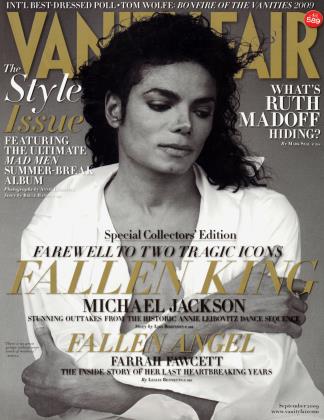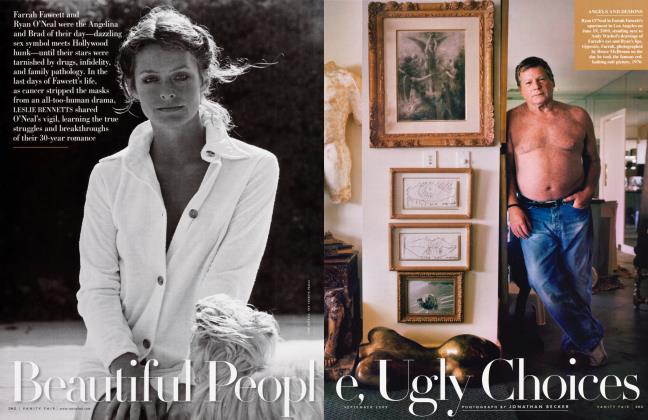Sign In to Your Account
Subscribers have complete access to the archive.
Sign In Not a Subscriber?Join NowCONTRIBUTORS
Tom Wolfe
Tom Wolfe has chronicled the foibles and follies of America's privileged classes for decades, both in fiction {The Bonfire of the Vanities) and nonfiction ("Radical Chic"). This month, with his story "The Rich Have Feelings, Too" (page 312), Wolfe tells of the current aerial warfare between crash-fallen C.E.O.'s who cannot imagine life in America without private planes and the "tarantulas": people—some in very high places—who burn with a morbid resentment of private-plane plutocrats and all they fly for. "I've been on just enough of other people's private planes," Wolfe says, "to see the status satisfaction of having obsequious pilots, who get drinks for you and say, 'Will that be all, sir? Don't hesitate to press the button.' It's such a lift—wow, they've really made it." Wolfe's next book, which he is currently researching, is tentatively titled Back to Blood, and will examine the lives of immigrants in America.
Patrick Demarchelier
Patrick Demarchelier has long been considered one of the world's leading photographers and in particular one of the fashion industry's greatest. In addition to shooting for numerous fashion magazines, such as Vogue and Harper's Bazaar, and for countless advertising campaigns, such as those of Calvin Klein and Louis Vuitton, Demarchelier has photographed some of Hollywood's most beautiful women for Vanity Fair covers, including Nicole Kidman and Angelina Jolie. This month, Demarchelier's work complements Amy Fine Collins's story on the history of haute couture ("Toujours Couture," page 316). Demarchelier uses his fine eye for style to capture exquisite archival gowns from five renowned ateliers: Jean Paul Gaultier, Christian Lacroix, Dior, Chanel, and Armani Prive. "We went backstage in the couture houses, where the seamstresses spend months at a time hand-sewing one dress," Demarchelier says. "The gowns were super-chic, and the quality was just superb—perfect for photographs."
CONTINUED ON PAGE 128
CONTINUED FROM PAGE 126
Meryl Gordon
Meryl Gordon began researching Brooke Astor in 2005, long before the philanthropist's life and assets became center of the legal battle that Gordon chronicles this month in "The New Astor Court," page 284. And after following Astor's story so closely all these years, Gordon—whose 2008 book, Mrs. Astor Regrets, has become an unofficial handbook for the legal teams on both sides of the case—finds herself quite saddened by the strife that is now consuming the late socialite's family and friends. "A video of Mrs. Astor's lOOth-birthday party was played in court and it showed everyone in happier times. Who could have imagined that it would be used in a courtroom where her son is on trial?" says Gordon, who goes to the courtroom every day. "I never thought I'd cry in court, but there was something about that video that made me tear up." The paperback version of Mrs. Astor Regrets, updated with new material from the trial, will be published by Houghton Mifflin in October.
Jonathan Becker
For this month's story about Farrah Fawcett (page 302), contributing photographer Jonathan Becker visited the late star's Los Angeles apartment just a few days before her death to photograph the people and things she would soon leave behind. "Ryan O'Neal and best friend Alana Stewart were there commiserating, along with Vanity Fair contributing editor Wendy Stark, another good friend," says Becker. "It was an awfully sad day, the sort that bestows a sense of scale and timeless perspective." And evidence of Fawcett's hard-fought battle with cancer was unmistakable: "Hospital supplies and gadgets of all kinds were stacked and stored in corners away from the elegant star's aesthetic environment."
Amy Fine Collins
Amy Fine Collins became interested in haute couture as a child, when she discovered, inside a drawer, her mother's fashion sketches from Paris in the 1950s. "At the time my mother thought that might be her profession," says Collins, who writes a comprehensive history of this exalted form of fashion in "Toujours Couture," page 316. Her mother became an art historian instead, and so eventually did Collins. But, reversing her mother's path, she found her way back to fashion. "Prices are high for haute couture," Collins acknowledges, "but then so are they for fine art and Formula One racecars." Collins, pictured here with designer Ralph Rucci (far right), also maintains, together with editor Graydon Carter, deputy editor Aimee Bell, and contributing editor Reinaldo Herrera, the International Best-Dressed Poll, which begins on page 232.
CONTINUED ON PAGE 130
CONTINUED FROM PAGE 128
Lisa Robinson
This month, contributing editor Lisa Robinson unearths some of the interviews she did with Michael Jackson during the 18 years she talked to him regularly. "Listening back to my tapes, I was struck by how he slowly changed from an outgoing, inquisitive teenager to a more distrusting, conflicted adult," says Robinson, pictured here with Michael at his family's home in Encino, California, in 1972. Robinson has profiled the late French singer Serge Gainsbourg, U2, Beyonce, and Eminem for Vanity Fair, and she wrote last year's oral history of Motown. "When I did the Motown story, Smokey Robinson told me he thought Michael was one of the best who ever did it—the singing, dancing, records, the whole package—but somewhere he just got lost, and it's easy to do."
James Wolcott
Look up the noun "scold" in the fourth edition of The American Heritage Dictionary and you'll find Vanity Fair contributing editor James Wolcott's observation usually grows more tetchy and ... may even become a big-league scold." Asked whether he finds himself succumbing to this tendency, who writes this month about Larry King's role as our culture's reigning M.C. of celebritydeath coverage, emphatically objects. "Oh no—I try not to be a scold," he says. "People are going to do what they're going to do. I am sort of more interested in why they did it and what it says. I don't believe in telling people, 'You shouldn't get this worked up about Michael Jackson's death—there are bigger things to get upset about.' If that's what they're upset about, then it does no good."
Kale Reardon
In "The Queen of Cozy Cool," page 208, Vanity Fair contributing editor Kate Reardon profiles Anya Hindmarch, the British handbag designer whose now famous I'M NOT A PLASTIC BAG tote brought her worldwide attention (and a Member of the Order of the British Empire honor from the Queen) after its debut, in 2007. "That bag changed the mood of England," Reardon says. "Of all the fashion initiatives to raise environmental awareness, that bag has had the greatest impact." This fall, Hindmarch will introduce a bespoke workshop, where customers can team with designers to create personalized wallets, journals, and other items. "It's going to have your name on it, but with Anya's stamp of taste and class," says Reardon, who lives in London and runs the wiki of women's wisdom, toptipsforgirls.com.
CONTINUED ON PAGE 132
CONTINUED FROM PAGE 130
Michael Wolff
No stranger to media moguls, having covered virtually every magnate in the world, contributing editor Michael Wolff examines a different type of master of the universe this month (page 202): Italy's prime minister, Silvio Berlusconi. "Berlusconi is much more a mogul than he is a politician," Wolff says. "Where politicians require a certain sense of modesty, even false modesty, Berlusconi has none. He does what he wants." And while the prime minister has endured countless scandals, the latest may be the most salacious: Berlusconi's wife is filing for divorce after he was allegedly out carousing with an 18-year-old model. Wolff's Rupert Murdoch biography, The Man Who Owns the News, will be out in paperback this winter.
Bruce Handy
Though deputy editor Bruce Handy didn't begin watching AMC's award-winning series Mad Men until Season Two, he was quickly drawn into what he considers the best show on television. While reporting "Don and Betty's Paradise Lost," page 268, Handy was allowed a rare glimpse into the inner workings of the Los Angeles set. "One day while I was there they were shooting in the Sterling Cooper offices. It was fully dressed with dozens and dozens of extras, secretaries and guys in suits, like the 60s came back from the dead," Handy explains. "The detail on the set is amazing—you go into Don Draper's office and even the books on his bookshelf are books he might really have." Handy continues, "I think Mad Men is pretty much the state of the art of film narrative right now. For me, it felt like being able to be on the set of Apocalypse Now in the 70s or The Wizard of Oz in the 30s."
John Banta
Vanity Fair s research director, John Banta, has spent two decades fact-checking. Working behind the scenes, he is responsible for ensuring the factual correctness of all V.F. stories. "Our brief is to entirely deconstruct and examine every detail and implication of a story prior to publication," Banta says. "Not surprisingly, this can be an unsettling process for all involved, | especially the author, but in the end we hope our meddling improves the story without detracting from it. We try to leave no fingerprints." With so much experience, one would expect that Banta has become accustomed to the stress of searching for the truth. "I have a recurring nightmare wherein one of our writers submits an expose of the fact-checking process, and we must fact-check ourselves fact-checking the writer."
 View Full Issue
View Full Issue






Subscribers have complete access to the archive.
Sign In Not a Subscriber?Join Now